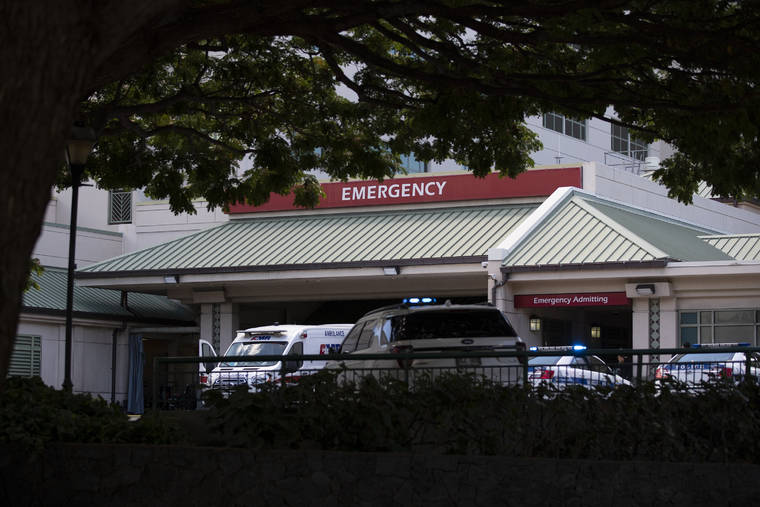Editorial: Health care gaps put public at risk

CINDY ELLEN RUSSELL / CRUSSELL@STARADVERTISER.COM
The emergency dock at Queen’s Medical Center is seen on Aug. 28.
At least part of the strain that Hawaii’s health-care system is now enduring amounts to simple math. The calculation that hospitals have been making here is that of all those testing positive for COVID-19, 1 in 10 will need hospitalization.
Only 1-3% of those will occupy an intensive care unit bed, but given Hawaii’s slim provisions for such patients, statewide, it hasn’t taken very long in the current case surge to put capacity under duress. There are only 244 ICU beds statewide, mostly on Oahu, which is why the state is taking such pains to protect the neighbor islands.
The other part is harder to quantify. Doctors and nurses are burning out. Nobody should be expected to maintain their current pace of work for as long as they have for the duration of the current, worrisome spike in infections.
In fact, it’s staffing that’s most needed. Honolulu Star-Advertiser staff writer Rosemarie Bernardo gathered figures from officials acknowledging that Hawaii has more than 3,000 hospital beds statewide, which certainly could be surged in annex facilities, if needed. However, they added, on any given day available staffing can cover only two-thirds of that capacity.
Overcoming this caregiver deficit is the most essential element for protecting community health in the ongoing coronavirus pandemic. Hawaii’s health-care system is both fragile and absolutely crucial in managing the crisis..
“Our staff, our nurses and physicians, are very tired,” Jill Hoggard Green, chief executive officer at The Queen’s Medical Center, said last week, addressing the House Select Committee on COVID-19 Economic and Financial Preparedness. “Many of them are working double shifts to make sure they are meeting the needs.”
Don't miss out on what's happening!
Stay in touch with breaking news, as it happens, conveniently in your email inbox. It's FREE!
In addition to getting medical “travelers” — primarily nursing staff from other locations — Green said that Hawaii hospitals collectively have submitted a request to the Hawaii Emergency Management Agency and the Federal Emergency Management Agency.
They are seeking funds for 150 additional caregivers who would be dispatched to smaller hospitals that would enable them to take more patients from the overburdened larger facilities. In addition, Queen’s individually is seeking 42 additional staffers, primarily nurses experienced in critical care, emergency care and dialysis.
The release of these funds is crucial, but so is routing around bureaucratic delays. Government and health-care industry providers must work “arm in arm” to overcome hurdles that slow the effort to boost capacity, Green said — and that assessment is exactly on point.
“There can’t be barriers to getting the right things to the people that we all care for and serve, which is our ohanas and the individuals who live in our community,” she said.
Getting this money isn’t the only part of the equation. There are also federal funds allotted by Congress in the CARES Act that will help hospitals hold up and minimize further community spread of the disease.
One appropriation authorized by the Legislature in its CARES spending plan was for $100 million for personal protective equipment (PPE) for hospitals and myriad front-line institutions.
However, in signing the final bill, Gov. David Ige reduced the amount to $61 million. The governor adjusted amounts throughout the package, aiming to leave more funds for discretionary COVID-19 spending, anticipating the arrival of further federal aid.
But such aid is anything but clear, given the political complexities of a national election year. Ige will need to review these amounts in the context of the surge in infection cases.
Broadly, the governor needs to communicate more clearly to the general public how the state intends to close the gaps in the health-care system. Hawaii residents justifiably feel anxious hearing about shortfalls in staffing and care, and need some straight talk about the plan for resolving them.
The PPE are necessary to ensure that doctors and nurses are able to do their jobs in relative safety. Staffing is in short supply, so warding off sickness among clinicians is an imperative. Outbreaks in nursing facilities and, in particular, at Maui Memorial Hospital show how easily institutional infections can take hold, and spread.
For their part, hospital managements must work proactively to stockpile PPE and other needed equipment and supplies more than was the case at the outset.
That’s the assessment of some well-positioned people within the industry. Among them, Daniel Ross, president of the Hawaii Nurses Association, told the Star-Advertiser that hospitals have not planned ahead as well as they should.
“As the strain gets worse, more things are likely to fall to the side,” Ross added. “Nurses have expressed feeling like they are expendable.”
Nothing could be further from the truth, of course. But talk is cheap. Only aggressive action — implementing a plan for reinforcing Hawaii’s hospitals — can convince isle caregivers that their patients, present and future, care for them as well.



